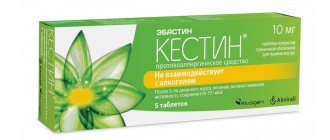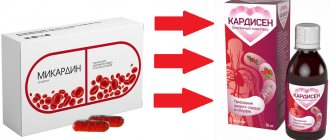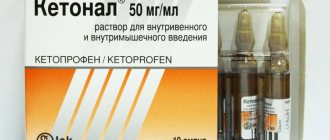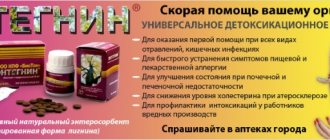Release form and composition
- solution for intravenous and intramuscular administration: transparent, yellowish (5 ml in dark glass ampoules, 5 ampoules in a tray, 1 tray in a cardboard box);
- tablets: round, flat, with beveled edges, pale yellow, with a line on one side and MICRO engraving on the other (10 pcs. in blisters or strips, in a cardboard pack of 1, 2 or 10 blisters/strips).
Active ingredients in 1 ml solution:
- metamizole sodium (analgin) – 500 mg;
- pitofenone hydrochloride – 2 mg;
- fenpiverinium bromide – 0.02 mg.
Auxiliary components: hydrochloric acid, water for injection.
Active ingredients in 1 tablet:
- metamizole sodium – 500 mg;
- pitofenone hydrochloride – 5 mg;
- fenpiverinium bromide – 0.1 mg.
Auxiliary components: methylhydroxybenzoate, povidone, purified talc, corn starch (anhydrous), magnesium stearate, lactose.
Composition and effects
The tablets contained three active substances. In addition, auxiliary substances are used for production to create the desired shape and impart a certain taste.
The therapeutic effect is provided by the following components:
- Metamizole sodium, which is a pyrazolone derivative. The substance is characterized by pronounced analgesic, antipyretic and antispasmodic properties.
- Pitophenone hydrochloride, which has a direct myotropic effect on smooth muscles, against the background of which it relaxes and spasms are relieved.
- Phenpiverinium bromide, which has an anticholinergic effect and has an antispasmodic effect on smooth muscles.
After taking the drug orally, the initial positive result is observed after approximately twenty minutes. Maximum therapeutic effect after four hours. Additionally, the combination of active components has an antipyretic effect.
The active ingredients are quickly absorbed after administration in the gastrointestinal tract. The drug undergoes biological transformation in the human body and, after reactions, new metabolites are formed in the intestinal wall. They bind to plasma proteins up to 60%, which explains the high effectiveness of the product.
Indications for use
- relief of mild and moderate pain syndrome due to spasms of smooth muscles of internal organs: intestinal colic, renal colic, biliary colic, spasm of the ureter and bladder, postcholecystectomy syndrome, biliary dyskinesia, algodismenorrhea;
- relief of pain after diagnostic procedures and surgical interventions (as an adjuvant);
- short-term symptomatic therapy: neuralgia, sciatica, arthralgia, myalgia.
Took
Bral (metamizole sodium + pitofenone hydrochloride + fenpiverinium bromide) is a combined analgesic and antispasmodic drug from an Indian pharmaceutical company. The bral can be used for smooth muscle spasms, as well as for pain of a wide variety of etiologies. It is used for spasms of the stomach, intestines, urinary and biliary tracts, dyskinesia of the gallbladder and biliary tract, painful menstruation. It is allowed to use it for myocardial infarction and other manifestations of coronary heart disease associated with pain (it should be noted that the drug does not impair the supply of oxygen to the myocardium), and for migraines. The set of active substances of the drug ensures mutual enhancement of the pharmacological effect of each of its components separately. Metamizole sodium (in our country it is better known under the trade name “analgin”) is an analgesic whose action includes both central and peripheral components. The central mechanism is due to the suppression of impulse transmission through nociceptive neurons to the pain centers of the central nervous system, as well as a decrease in the frequency of discharges in spinal cord neurons. The peripheral mechanism is realized through inhibition of the synthesis of pain mediators prostaglandins and inactivation of pain receptors under the influence of specific stimulants. Piperidine derivative pitofenone hydrochloride is a myotropic antispasmodic, whose action is based on suppressing the activity of acetylcholinesterase (an enzyme that catalyzes the hydrolysis reaction of acetylcholine and thereby causes relaxation of the muscle cell). Fenpiverinium bromide is an m-anticholinergic blocker that complements the myotropic effect of pitofenone hydrochloride on smooth muscles. The combined antispasmodic effect of the drug is due to an increase in the pain threshold and a decrease in the excitability of smooth muscles (metamizole sodium is responsible for this), the anticholinesterase activity of pitofenone hydrochloride and fenpiverinium bromide, complemented by the papaverine-like effect of the former.
Bryl passed all the clinical trials conducted with his participation with honor.
One of them took place at the department of the National Medical University. A.A. Bogomolets (Kyiv, Ukraine). Participants are patients suffering from biliary dyskinesia. The “rival” was taken, with which its clinical effectiveness was compared - the Yugoslav drug baralgin with an identical composition. The assessment was carried out in accordance with a specially developed three-point scale. As a result, it was found that both drugs equally effectively relieve hepatobiliary symptoms, eliminating dysfunction of the sphincter apparatus of the biliary tract. It showed the greatest effectiveness in hepatic colic. During the study, the drug was well tolerated by patients. During the entire medication course, no negative side effects requiring dose reduction or cessation of pharmacotherapy were observed. At the end of the study, a conclusion supported by facts was made: the severity of the analgesic and antispasmodic properties of the drug was not inferior to those of the comparison drug, which is the original “brand” drug. The favorable safety profile and optimal therapeutic efficacy/cost ratio of the drug allow us to recommend taking it for widespread use in the treatment of the diseases and pathological conditions stated in the instructions.
Bral is available in tablets. For adults and children over 15 years of age, the recommended dose is 1-2 tablets 2-3 times a day. For children 12-14 years old, a single dose of the drug is 1 tablet, the maximum daily dose is 6 tablets; for children 8-11 years old - half a tablet, maximum daily dose - 4 tablets; for children 5-7 years old - the same half tablet with a daily maximum of 2 tablets. The tablets should not be chewed and should be taken with a sufficient amount of water. Bryl is not compatible with alcohol. With long-term treatment (and this is considered a drug course lasting a week or more), monitoring of peripheral blood parameters and liver functions is indicated. Bral is strictly not recommended for use for the relief of acute abdominal pain syndrome.
Contraindications
- chronic heart failure in the stage of decompensation;
- tachyarrhythmias;
- stable and unstable angina;
- megacolon;
- intestinal obstruction;
- inhibition of bone marrow hematopoiesis;
- acute intermittent porphyria;
- closed-angle form of glaucoma;
- severe dysfunction of the liver and/or kidneys;
- prostatic hyperplasia, accompanied by clinical manifestations;
- deficiency of glucose-6-phosphate dehydrogenase;
- collapsed states;
- children up to 3 months (or body weight less than 5 kg) - for injection solution, up to 5 years - for tablets;
- first trimester and last 6 weeks of pregnancy;
- lactation (or feeding should be stopped);
- simultaneous use of radiocontrast agents and colloid blood substitutes;
- hypersensitivity to pyrazolone derivatives (butadione) and other components of the drug.
Carefully:
- tendency to arterial hypotension;
- impaired liver or kidney function;
- bronchial asthma;
- tendency to bronchospasm;
- age under 18 years;
- history of hypersensitivity to non-steroidal anti-inflammatory drugs or non-narcotic analgesics (including the aspirin triad).
Directions for use and dosage
Solution for intravenous and intramuscular administration
In this dosage form, Bral is intended for intramuscular (IM) and intravenous (IV) injections.
For adults and adolescents over 15 years of age with acute severe colic, the drug is administered slowly (over 2 minutes) intravenously in a dose of 2 ml; if necessary, a second dose is administered after 6–8 hours.
Intramuscularly prescribed 2 ml 2 times a day.
Recommended single doses for children depending on their age and body weight:
- 12–15 years (or 46–53 kg): IV or IM – 0.8–1 ml;
- 8–12 years (or 31–45 kg): IV – 0.5–0.6 ml, IM – 0.6–0.7 ml;
- 5–7 years (or 24–30 kg): IV – 0.3–0.4 ml, IM – 0.4–0.5 ml;
- 3–4 years (or 16–23 kg): IV – 0.2–0.3 ml, IM – 0.3–0.4 ml;
- 1–2 years (or 9–15 kg): IV – 0.1–0.2 ml, IM – 0.2–0.3 ml;
- 3–11 months (or 5–8 kg): IM only – 0.1–0.2 ml.
If necessary, repeated administration of the drug in the same doses may be prescribed.
Before injection, the solution should be warmed in your hand.
Bral is incompatible in the same syringe with other medications.
The duration of parenteral therapy is no more than 5 days.
Pills
In this dosage form, the drug should be taken orally, preferably after meals.
Recommended single doses:
- adults and adolescents over 15 years of age: 1–2 tablets;
- adolescents 13–15 years old: 1 tablet;
- children 8–12 years old: ¾ tablets;
- children 5–7 years old: ½ tablet.
Frequency of administration: 2–3 times a day.
The duration of treatment is no more than 5 days.
Increasing the dose or duration of therapy is possible only on the recommendation of a doctor and under his supervision.
Application
The optimal time to take the tablets was after a meal, washed down with at least half a glass of clean water. The dosage is selected individually, taking into account the patient’s condition and the purpose of therapy. To reduce the risk of negative side reactions, you should take the minimum effective dose that relieves pain.
The recommended daily dosage, according to the instructions for use for children over 15 years of age and adults, is up to 2 tablets in 2-3 three divided doses. If indicated, it is allowed to take no more than 6 tablets per day. The duration of taking the drug is no more than 3 days.
Byrol tablets, which are available in pharmacies without a prescription, interact with many other medications. Therefore, it is strictly forbidden to use them without a doctor’s recommendation. The drug should be stored out of the reach of children. Shelf life: 3 years at a temperature not exceeding 25°C.
Side effects
When taking Bral in therapeutic doses, the drug is usually well tolerated.
In rare cases, the following side effects have been reported:
- allergic and dermatological reactions: skin rash, itching, urticaria, angioedema, anaphylactic shock, malignant exudative erythema, toxic epidermal necrolysis;
- from the digestive system: dry mouth, burning sensation in the epigastric region;
- from the nervous system: headache;
- from the cardiovascular system: dizziness, tachycardia, decreased blood pressure, cyanosis;
- from the respiratory system: with a tendency to bronchospasm - an attack of bronchospasm;
- from the hematopoietic system: leukopenia, thrombocytopenia, agranulocytosis (unmotivated rise in temperature, difficulty swallowing, sore throat, stomatitis, chills, symptoms of proctitis or vaginitis);
- from the urinary system: usually when taking high doses or for a long time - anuria, oliguria, proteinuria, red urine, interstitial nephritis, difficulty urinating;
- local reactions: with intramuscular administration - infiltrates at the injection site;
- other: accommodation paresis, decreased sweating.
Side effects and overdose
In most cases, if the recommended therapeutic doses are followed, the tablets are well tolerated. Occasionally, the medicine can provoke allergic reactions, which are manifested by skin rash and itching. In rare cases, anaphylactic shock has been observed. Sometimes, a headache, a burning sensation in the epigastric region, and dry mouth may occur.
The instructions contain warnings about possible negative reactions while taking the drug in the form of dizziness or decreased blood pressure. Long-term use of the drug can provoke disorders in the circulatory system: thrombocytopenia, agranulocytosis, leukopenia. Patients with a predisposition to bronchospasm are at risk of triggering an attack.
More rare side effects that may occur when taking the medicine are indicated in the instructions and you should definitely get acquainted with them, and if negative reactions occur, you should definitely inform your doctor.
An overdose of the drug can provoke dangerous reactions in the body. With a single dose of large doses, hypothermia, palpitations, drop in blood pressure, and shortness of breath occur. Additionally, vomiting and impaired consciousness may begin, as well as other dangerous symptoms, which the instructions for use warn about.
As a matter of urgency, if any signs of overdose appear, drink at least a liter of clean water and induce vomiting. In severe cases, gastric tube lavage may be necessary. After this, you need to take saline laxatives and absorbents. If the condition worsens, hospitalization is carried out in order to provide professional medical care in a hospital setting.
special instructions
Bral should not be used to relieve acute abdominal pain until the cause of its occurrence has been determined.
During treatment, you should not drink alcoholic beverages; it is recommended to refrain from performing potentially hazardous activities, including driving a car.
In the form of a solution, Bral is prescribed in emergency situations and in cases where oral administration is not possible (for example, in case of impaired absorption from the gastrointestinal tract).
Intravenous administration should be carried out slowly, with the patient lying down, under the control of blood pressure, respiratory rate and heart rate.
Particular care must be taken if it is necessary to administer a solution in a dose of 2 ml, since a sharp decrease in blood pressure is possible.
With long-term treatment (more than 5 days), it is necessary to monitor the functional state of the liver and the picture of peripheral blood.
Drug interactions
- other non-narcotic analgesics: toxic effects are mutually enhanced;
- tricyclic antidepressants, oral contraceptives, allopurinol: the metabolism of metamizole sodium in the liver is disrupted, its toxicity increases;
- butyrophenones, H1-histamine blockers, phenothiazines, amantadine, quinidine: the M-cholinergic effect of fenpiverinium bromide is enhanced;
- ethanol: mutually enhancing effects;
- tranquilizers, sedatives: the analgesic effect of metamizole sodium is enhanced;
- indirect anticoagulants, hypoglycemic drugs, glucocorticosteroids, indomethacin: the severity of their action increases;
- H2-histamine blockers, codeine, propranolol: the Bral effect is enhanced;
- cyclosporine: its concentration in the blood decreases;
- chlorpromazine or other phenothiazine derivatives: severe hyperthermia may develop;
- barbiturates, inducers of microsomal liver enzymes (including phenylbutazone): the effect of metamizole sodium is weakened;
- cytostatics, thiamazole: the risk of developing leukopenia increases.
In the form of an injection solution, Bral is pharmaceutically incompatible with other drugs.
If it is necessary to use any other drug simultaneously, consult your doctor.








